ABSTRACT
Equines are essential in the farming and transport systems of many areas of developing countries including Ethiopia. However, their socioeconomic importance is often under recognized and they suffer from poor husbandry practices which threaten their welfare and health. Wound is main problem emanated from such practice that results in deviation of their health and welfare. Cross-sectional study was conducted from November, 2016 to January, 2017 with the objective to determine the prevalence and associated risk factors of wound in randomly selected equine in and around Assella town. Physical examination and semi-structured questionnaire were simultaneously employed to collect necessary information and possible risk factors. Out of 400 equines (278 horses and 122 donkeys) examined 250 were found to have wound on one or more of their body parts and the overall would prevalence was 62.5% of which 65.8% was in horses and 54.9% was observed in donkeys. Multivariable logistic regression analysis showed that the prevalence of wound was significantly higher in horse (65.8%) than donkeys (54.9%) (OR=3.509; 95% CI=1.505, 8.184, p= 0.004), the prevalence was higher in adult (66.6%) than in young equine (43.8%) (OR= 2.782, CI= 1.244, 6.225, p=0.013), in males (69.4%) than in females (42.1%) (OR= 4.192, CI=2.122, 8.281, p= 0.000), in poor body conditioned equines (97.0%) than in good body conditioned equines14.6% (OR=454.614, CI=124.291, 1662.829). Moreover, the prevalence of wound in relation to harnessing type was 69.3, 62.8 and 52% in grass, plastic and traditionally prepared leather, respectively. However, this variation was not statically significant (p= 0.111).There was significant variation in causes of wound between horse and donkeys and the wound caused by improper harness was highest (X2=39. 357, P-=0.000) in both horses (35.55%) and donkeys (25%). Similarly, the owners response to the management of wound in horses and donkeys was significantly (X2=15.308, p=0.032) different and the majority of donkeys (71.6%) and horses (65.5%) did not receive any help from their owners. This study revealed a high prevalence of equines wound in and around Asella town which indicate the prevailing situation of equine welfare and health problems. This strongly calls for a continuous awareness creation to equine owners on proper management and handling and improve their welfare and health thereby enhance the utilization and improve the livelihood of the community.
Key words: Equines, wound, prevalence, risk factors, Asella.
The equine population of the world is currently reported to be about 112.5 million of which 44.3 million donkeys, 58.5 million horses and the remaining are mules (FAO, 2013). The number of equines in Africa is in the range of 17.6 million comprising 11.6 million donkeys, 2.3 million mules and 3.7 million horses (Mulate, 2005). In the distribution pattern, 98% of all donkeys, 97% of all mules and 60% of all horses were noted to be found in developing countries (Fielding, 1991). Ethiopia possesses approximately half of Africa’s equine population with 37, 58 and 46% from total of donkeys, horses and mules, respectively (FAO, 2003). The country ranks 8th in the world and there are about 7.88 million donkeys being the second largest donkey population in the world next to China, 0.41 million mules and 2.08 million horses (CSA, 2016).
Equines (donkeys, mules and horses) play an important role as working animals in many parts of the world, for packing, riding, carting and ploughing (Feseha et al., 1991). They have a prominent position in agricultural systems of many developing countries including Ethiopia (Feye and Bekele, 2016). Equine power is very crucial in both rural and urban transport system. This is because of its cheapness and availability and so provides the best alternative transport means in places where the road network is insufficiently developed and the landscape is rugged and mountainous and in the cities where narrow streets prevent easy delivery of merchandise (Feseha et al., 1991). In areas away from roads, many people use mules and donkeys to transport food and other supplies to villages (Yoseph et al., 2005). Horses involved in pulling carts often work continuously for 6 to 7 hours/day, carrying 3 to 4 persons in a single trip. Donkeys often are involved in more multipurpose activities than horses. They transport goods to and from markets, farms, and shops, travelling long distances (Biffa and Woldemeskel, 2006).
Despite the huge numbers of equine population and their invaluable contributions as an engine that power rural as well as urban economic development of the nation, equines in Ethiopia are the most neglected animals and little attention is given to study their health status. Equines suffer from a number of diseases including infectious and non-infectious throughout the globe affecting the health status (Sumbria et al., 2017). The information on the wound prevalence and associated risk factors are scarce at national level and in Assella in particular despite, the invaluable contribution of such study in exploring their welfare and health status. Therefore, the main objectives of this study were to determine the prevalence and associated risk factors of equine wounds in and around Asella town, south eastern Ethiopia.
Study area
The study was conducted in Asella town of Arsi zone, Oromia region, which is located in South East of Ethiopia within 6° 59’ and 8°49’ latitude and 40°44’ E longitudes and is located at 175 km South East of Addis Ababa. The town has an elevation of 2,430 m.a.s.l and characterized by mid subtropical temperature ranging from 5 to 28°C. The annual average rainfall is 1200 mm and mostly with clay type of soil and in rare case black soil (APEDO, 2007). The annual temperature range is 10 to 22.6°C. It has a daily maximum temperature that can reach up to 28°C and minimum temperature of 10°C (NMSA, 2013). Asella town and the surrounding farming community, has a total area of 300.21 km2. This, about 208.43 km2 (69.4%) of the total area is agricultural land, 40.61 km2 (13.5%) pastoral land, 6.74 km2 (2.3%) forest, 39.34 km2 (13.5%) land for construction and 5.08 km2 (1.69%) non-fertile land (ABTW, 2010/2011).
Study design and study population
A cross-sectional study design was employed from November, 2016 to January, 2017 for assessing the prevalence and associated risk factors of equine wound in and around Asella town. The study population include local breed of equines (horses and donkeys) population found in and around Assella town. The population comprise horses and donkeys of different sex, age, and body condition.
Sample size determination and sampling technique
The sample size for the study was calculated using the formula given by Thrusfield (2007) based on the expected prevalence of 50%, with 95% confidence interval and 5% absolute level of precision. Accordingly, the required number of animals was 384. However, to increase precision the sample size was increased to 400. Simple random sampling method was used for selecting study population.
Study methodology
Each of the selected equines was physically examined to check for any grossly visible wounds. Furthermore, the age and body condition determination were performed during physical examination. The age of the selected equines were determined by inspecting and estimating the incisor eruption times (Crane, 1997; Svendsen, 1997). Equines were grouped into two age categories namely young (< 5 years) and adult (>5 years). The body condition was scored as poor, medium and good as described by Carroll and Huntington (1988) and Svendsen (1997).Wounds were classified as
abrasion when it involves superficial denuding of the epidermis with minimal (capillary) bleeding and usually some serum/plasma exudation. Non-penetrating wounds of the skin that arises from abrasion against a rough or hard object such as a road surface were considered as abrasion. Moreover, the wounds in the skin and hoof that arises from sharp objects such as nails, glass shards, or other foreign bodies that penetrate and generally look minor by making small skin tears or holes were categorized as puncture wound. Furthermore, a wounds with sharp defined margin and caused by sharp metal or glass in which the skin is cut cleanly with minimal tearing and bruising of the wound margins were categorized as incision wounds whereas, the traumatic tearing of the skin in an uncontrolled direction was considered laceration as described by Knottenbelt (2003). Wounds were also classified as severe when there was ulceration involving a pronounced contusion in wide areas, tissue hypertrophy and sever complication. A wounds involving coalition of small wound with tissue sloughing involving no complication and hypertrophy and some with chronic courses were categorized as moderate wounds. Furthermore, the wounds that involve only loss of epidermis and superficial layers with no further trauma were categorized as mild according to classification used by Biffa and Woldemeskel (2006). In addition to physical examination a semi-structured questionnaire was also developed to collect data, including harnessing type, intensity of wound, cause of wound, and owners’ responses with regard to the management of wounds.
Data management and analysis
The data was entered and edited in a Microsoft Excel spread sheet and analysed using Statistical Package for Social Sciences version (SPSS) 20. Descriptive statistics was used to determine frequencies and percentages of the data. Prevalence of wounds related to specific risk factors was determined as the proportion of would positive animals out of the total sample. Specific category frequency of a given factor was computed as the proportion of cases out of the total cases of that hypothetical factor. The strength of association of factors to occurrence of wounds was investigated using multivariable logistic regression. The 95% confidence interval of OR and p-values were used to describe statistical significance associations and value of p<0.05 was considered as significant. Furthermore, chi-square test was used for determining difference between horse and donkey in relation to wound by type and intensity, distribution, causes and owners’ responses to the management of wound.
In this study a total of 400 equines (278 horses and 122 donkeys) were investigated to determine the prevalence and associated risk factors of wound. The overall prevalence of 62.5% was recorded of which 65.8% was from horses and 54.9% from donkeys. In this investigation, significantly higher prevalence of wound was observed in horse (65.8%) than in donkeys (54.9%). Furthermore, the age of animals was also found to be statistically significantly associated with wound prevalence being higher in adult (66.6%) than in young (43.8%). Adult animals were 2.782 times more likely to be positive of wound than young (Table 1).The prevalence of wound based on sex was 69.4% and 42.1% in males and females respectively. This variation was also statistically significant being higher in male (69.4%) which was 4.192 times more likely to be wound positive than female (42.1%). The association of body condition with occurrence of wound was found to be significant (p= 0.000) and highest in poor body conditioned equines (97.0%) 454.6 followed by medium body conditioned equines (58.5%) which were 15.240 times more likely to be wounded than good body conditioned equines (Table 1). The prevalence of wound in relation to harnessing type was 69.3, 62.8 and 52% in grass, plastic and traditionally prepared leather, respectively. However, this variation was not statically significant (p=0.111) despite the observation of highest wound prevalence in grass harnessing type (OR=2.205, CI=0.821, 5.925) and plastic harnessing type (OR=0.876, CI=0.324, 2.367) than traditionally prepared leather. The prevalence of wound in relation to harnessing type (plastic, grass and traditionally prepared leather) is summarized in Table 1.
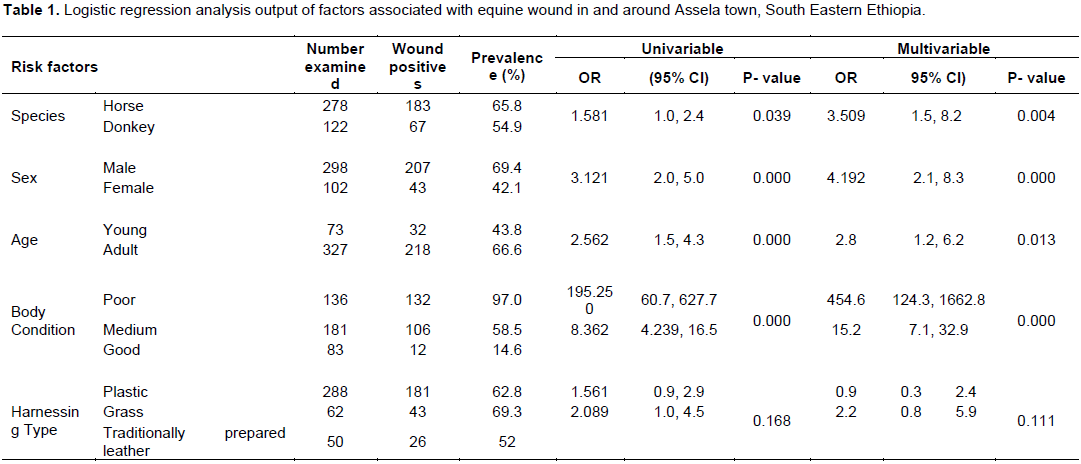
Abrasion was the most frequently observed wound type in both horses (50.2%) and donkeys 55.2%) and followed by lacerative (35.2%), puncture (9.6%) and incision wound (3.6%). Furthermore, moderate wounds were most frequently observed than other wound severity in both horses and donkeys which was 62% of the cases. No significant difference in both type and intensity of wound was observed between horse and donkeys (p>0.05).The proportion of wound by type and intensity was summarized in Table 2.
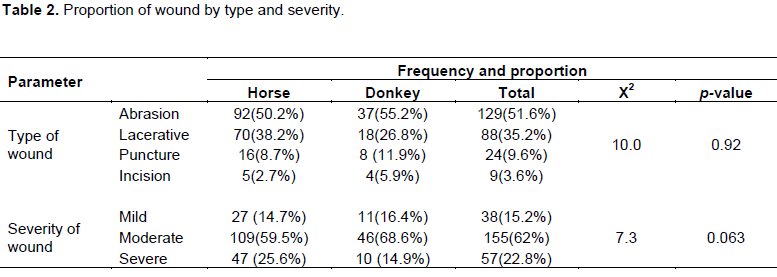
In the examined equines wound was frequently observed on wither (23.6 %) and followed by back and shoulder (Figure 1) wound which account for about 15.6 and 12% of the wound distribution respectively. However, no significant difference (p>0.05) was observed between horse and donkey in relation to distribution of wound on various body parts. No single wound was observed on pre scapular area of donkeys compared to 1.6% in horses. Wound on mixed area (distributed in different area) accounts for 22.4% of wound observed in horse. The distribution wound on various body parts is summarized in Table 3.
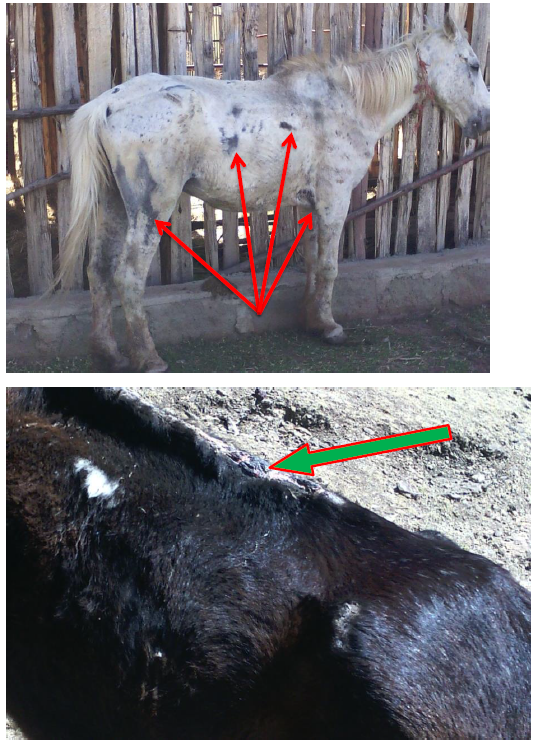
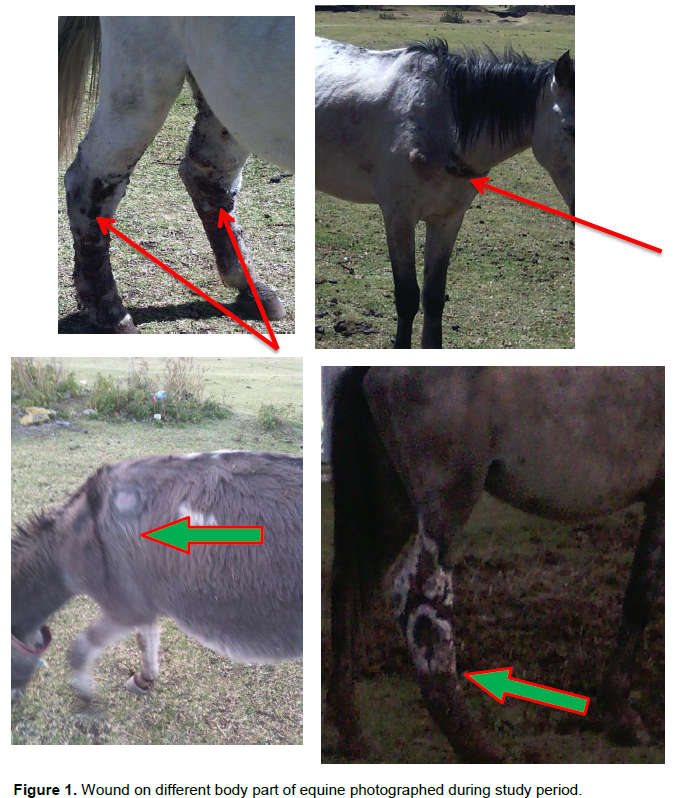
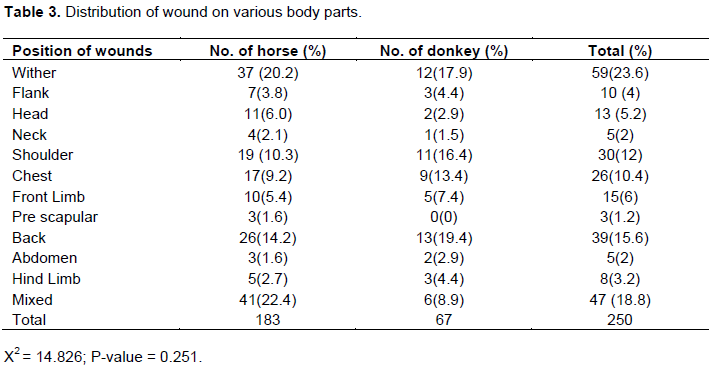
There was significant variation in causes of wound between horse and donkeys and the wound caused by improper harness was highest (X2=39. 357, P-value= 0.000) in both horses (35.55%) and donkeys (25%). The next leading cause of wound was infectious disease in horses (11.4%) and overworking (19.4%) in donkeys. None of the observed donkeys had wound caused by nail piercing (Table 4). In addition owners response to the management of wound in horses and donkeys are significantly (X2=15.308, P-value 0.032) different, majority of donkeys (71.6%) and horses (65.5%) did not receive any help from their owners. The owner’s responses to the management of wound are summarized in Table 5.
This study revealed an overall prevalence of 62.5% of equine wound in and around Assela town which is in agreement with the finding of study by Fikru et al. (2015) who reported an overall prevalence of 64% in and around kombolcha town. The result of current study is higher than the finding of Tesfaye et al. (2015) who reported 30.3% in and Around Mekelle town, Northern Ethiopia and result of Usman et al. (2015) who reported 37.9% of equine wound prevalence in and around Batu Town, East Shoa, Central Ethiopia. However, this finding is lower than the reports of Biffa and Woldemeskel (2006) who reported 72.15% of equine wound prevalence in Hawassa town, Southern Ethiopia. This variation might be due to difference in husbandry practices and health care given by the owner to their equines among the study area.
Similar to the report of Fikru et al. (2015) the present study showed higher prevalence of wound in horse (65.8%) than donkeys (54.9%). This could possible associated higher ability of donkey to survive in harsh condition and less susceptibility to infectious disease than horse. Furthermore, this may be due to the fact that horses are more commonly used in cart than donkeys which may expose them to different cause of wound like nail piercing and higher number of horse included in this study might also be associated with higher prevalence of wound in horse.
This study revealed higher prevalence of wound in horses as compared to a study conducted in Mekelle, Northern Ethiopia (Sisay, 2013) who reported 25% prevalence of wound in cart horses. However, this result is almost similar with result of Biffa and Woldemeskel (2006) and Fikru et al. (2015) who reported 65.4 and 64.20% prevalence in Hawasa and Kombolcha town, respectively. The prevalence in donkey was comparable with finding of Herago et al. (2015) who reported 58.6% in Wolaita SoddoZuria district. However, this finding is higher than the result of Tsega et al. (2016) and Birhan et al. (2014) who reported 30.3 and 42.2%, respectively. Furthermore, this study revealed lower prevalence of donkey wound than the result of Fikru et al. (2015) and Biffa and Woldemeskel (2006) who revealed 63.40 and 79.4%, respectively. This variation in prevalence could be associated with variation in husbandry and management practice at deferent study area.In this study the age of animals was found to be significantly associated with wound prevalence being higher in adult (66.6%) than young (43.8%). This finding is in agreement with Biffa and Woldemeskel (2006), Birhan et al. (2014) and Fikru et al. (2015) who reported significantly higher prevalence in adult than young. This could be due to the fact that adult animals exposed to different types of diseases and stress in their entire life which may affect the normal process of wound healing. Furthermore, adult were made to carry heavy loads over long distances and hours this may expose them to wound The result of this study shows that the prevalence of equine wound was significantly associated with their sex and higher number of wound was observed in male (69.4%) than female (42.1%) (P=0.000). This result is also supported by Satessa and Lemma (2014) who reported significantly higher prevalence in males than females. This could be associated with work type since males are involved in works that predispose them to wound like cart pooling and they also suffer from overloading that lead to falling and consequently exposing them to wound. Furthermore, the higher number of male considered in this study could also be the possible reason.
In this study the association of body condition with occurrence of wound was significant (p= 0.000) and poor body conditioned animals are 454.614 times more likely to be wounded than good body conditioned (Table 1). This finding is in agreement with the report of Birhan et al. (2014) and Tsega et al. (2016) who reported significant difference between poor and good body conditioned equine. Furthermore, Pearson et al. (2000) and Mekuria et al. (2013) indicated that poor physically conditioned equines mainly due to malnutrition are the leading causes of sores in equine. The probable reason for such association is due to equine with a poor body condition score may have less natural padding protecting them from pressure, friction and shear lesions caused by saddle. Less owners’ attention to wound management and reduced immune defence mechanism of an animal with age advancement might also be the possible cause.
Similar to the finding of Fikru et al. (2015) abrasion was the most frequently observed wound type in both horses (50.2%) and donkeys 55.2%) and followed by lacerative (35.2%), puncture (9.6%) and incision wound (3.6%). There was significant variation in causes of wound between horse and donkeys and the wound caused by improper harness was highest in both horses (35.55%) and donkeys (25%).
This in line with other reports from peri-urban areas of Ethiopia such as Gondar North(Biffa and Woldemeskel, 2006), Mekelle (Helen, 2001) and Northern Ethiopia (Sisay, 2013).
With regard to wound management, the majority of equine owners did not receive any help from their owners which was in agreement With the finding of Biffa and Woldemeskel (2006) and Fikru et al. (2015) who similarly reported a widely existing equine welfare problem in Kombocha and Hawasa town, respectively.
This study revealed a high prevalence of equines wound in and around Assela town. Improper harnessing and infectious diseases were the major leading cause of the wound. Despite the significant role they have in day to day life of community the majority of equine did not receive any help from their owners while wounded. This strongly calls for a continuous awareness creation to equine owners on proper management and handling and improve their welfare and health thereby enhancing the utilization and improve the livelihood of the community. Furthermore, policies and legal frameworks that support animal welfare issues and inspect animal facilities should be promoted in order to ensure animal welfare issues.
The authors have not declared any conflict of interests.
REFERENCES
|
ABTW (2010/2011). Agricultural Bureau of TiyoWoreda Arsi Plan and Economic Development Office (APEDO) (2007). Socio Economic on Arsi Zone; Asella, Arsi. pp. 1-105.
|
|
|
|
Mulate B (2005).Preliminary study on helmenthosis of equines in south and north Wollo zones. J. Vet. Assoc. 9(2):25-37.
|
|
|
|
|
Biffa D, Woldemeskel M (2006).Causes and factors associated with occurrence of external injuries in working equines in Ethiopia. Int. J. Appl. Res. Vet. Med. 4(1):1-7
|
|
|
|
|
Birhan G, Chanie M, Tesfaye T, Kassa A, Mekonnen B, Wagaw N (2014). Incidence of wound and associated risk factors in working donkeys in Yilmana Densa District. Glob. Vet. 13(1):133-140.
|
|
|
|
|
Carroll CL, Huntington PJ (1988). Body condition scoring and weight estimation of horses. Equine Vet. J. 20(1):41-45.
Crossref
|
|
|
|
|
Crane M (1997). Medical. In: The professional hand book of the donkey, 3rd edition.Whittet Books Limited, 18 Anley Road,London W14 OBY. pp.19-36.
|
|
|
|
|
CSA (2016).Federal democratic republic of Ethiopia.Central statistical agency. Agricultural sample survey, Volume II, Report on livestock and livestock characteristics.Statistical bulletin 583, Addis Ababa, Ethiopia.
|
|
|
|
|
FAO (2013). Economic and social department. The statics division, online data base FAO. Available at: http://faostat.fao.org/default.aspx
|
|
|
|
|
FAO (2003). Food and agriculture organization, Rome, Italy. Available at: http://faostat.fao.org/default.aspx
|
|
|
|
|
Feseha G, Mohammed A, Yilma J (1991). Vermicular endoparasitism in donkeys of DebreZeit and Menagesha, Ethiopia. Donkeys, mules and horses in tropical agricultural development. Proc. Colloq. On donkeys, mules and horses. Eds. D. Fielding and R.A. Pearson, University of Edinburgh, Center for tropical veterinary medicine: UK. pp. 156-160.
|
|
|
|
|
Feye A, Bekele T (2016). Prevalence of Equine Lung Worm (Dictyocaulus Arnfieldi) and Its Associated Risk Factors in Jimma Town, South West Ethiopia. Adv.Life Sci.Tech. 40:26-30.
|
|
|
|
|
Fielding D (1991). The number and distribution of in the world in proceeding of the colloquium on donkeys, mules and horses in tropical agricultural development, Edinburgh, 3-6 September,1991. pp. 62-66.
|
|
|
|
|
Fikru A, Tadese A, Gebreegziabher Z (2015). Prevalence of Equine Wound and Associated Risk Factors in and around Kombolcha Town, North Ethiopia. J. Vet. Sci. Technol. 6:234.
|
|
|
|
|
Helen B (2001) The Gharry horses of Gonder. Draught Animal News. Centre for Tropical Veterinary Medicine: University of Edinburgh, Scotland. 35:23-24.
|
|
|
|
|
Herago T, Megersa M, Niguse A, Fayera T(2015). Assessment on Working donkey welfare issue in WolaitaSoddoZuria District, Southern Ethiopia. Glob.Vet. 14:867-875.
|
|
|
|
|
Knottenbelt DC (2003). Handbook of Equine Wound Management. Liverpool, UK: WB Saunders. pp. 5-11
|
|
|
|
|
NMSA (2013). National Metrology Service Agency. Addis Ababa, Ethiopia
|
|
|
|
|
Pearson R, Mengistu A, Agajie T, Eleanor F, David G, Mesfin A (2000). Use and management of donkeys in peri-urban areas of Ethiopia, Draught Animal Power Technical Report 5, Scotland, University of Edinburgh: Centre Trop. Vet. Med. 4:260-275.
|
|
|
|
|
Satessa GD, Lemma FA (2014). Prevalence of External Injuries in Working Equines in Mehal Saint Woreda of South Wollo Zone, Ethiopia. J. Vet. Adv. 1(4):654-660.
Crossref
|
|
|
|
|
Sisay WZ (2013). Causes and Factors Associated with the Episode of External Injuries in Cart-Horses of Mekelle Town, North Ethiopia. J. Vet. Adv. 3:265-274.
|
|
|
|
|
Sumbria D, Singla LD, Sharma A, Bal MS, Randhawa CS (2017). Molecular survey in relation to risk factors and haemato-biochemical alteration in Theileria equi infection of equines in Punjab Province, India. Vet. Parasit. Reg. Stud. Rep. 8:43-50.
Crossref
|
|
|
|
|
Svendsen ED (1997).Parasites abroad. The professional hand book of the donkey, 3rd edition, Whittet Books Limited, 18 Anley Road, London W14 OBY. pp.166-182.
|
|
|
|
|
Tesfaye A, Yohannes T, Habtamu T, Kalab G, Hagos T (2015). Survey of Common Skin Problem of Working Equines in and Around Mekelle, North Ethiopia. Acad. J. Anim. Dis. 4(1):30-38.
|
|
|
|
|
Thrusfield M (2007) Veterinary Epidemiology (3rd edn)Blackwell science Ltd London, UK. pp. 228-246.
|
|
|
|
|
Tsega AM, Worku Y, Tesfaye T, Nazir S (2016). Prevalence of Wound and Associated Risk Factors of Donkeys in Merawi District, North-Western Ethiopia. J. Anim. Res. 6(5):765-771.
Crossref
|
|
|
|
|
Usman S, HaimanotDisassa TK, Kebede TZG (2015). Health and Welfare Related Assessment of Working Equine in and Around Batu Town, East Shoa, Central Ethiopia. Nat. Sci. 13(10):1-8.
|
|
|
|
|
Yoseph S, Smith DG, Mengistu A, Teklu F, Firew T, Betere Y (2005). Seasonal variation in the parasite burden and body condition of working donkeys in East Shewa and West Shewa regions of Ethiopia. Trop. Anim. Health. Prod. 37(1):35-45.
Crossref
|
|